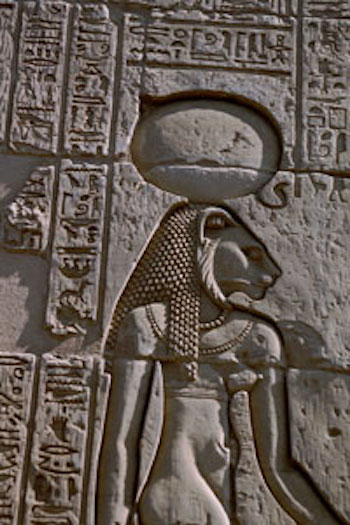
Sekhmet at the Temple of Kom Ombo.
Sekhmet is one of the oldest Egyptian deities. She was originally the warrior goddess associated with Upper Egypt prior to its unification in 2930 BCE. Her Lower Egyptian equivalent prior to this was Bastet. She had a variety of names including the ‘Lady of Terror’ and the Lady of Pestilence‚ both of which she received from The Book of the Dead. Sekhmet was also referred to as She Who is Powerful‚ which was a name the ancient Egyptians gave to any female deity whom they considered to be dangerous. She was depicted with the head of a lioness wearing a sun disk and a uraeus, as well as having the body of a woman. If she was shown seated, she would almost always be shown holding an ankh, which represented life. In contrast, an image of Sekhmet standing almost always shows her holding a sceptre made of papyrus, the symbol of Upper Egypt.
Sekhmet was very closely associated with the motherhood deity Hathor, and was considered to have the harsher traits of the two. This has led some modern Egyptologists to argue that by the later period they were two sides of the same deity, rather than two individual goddesses.
She was believed to have been terrifying, as well as the fiercest of all of the Egyptian hunter pantheon. For example, the Middle Kingdom text of the Tale of Sinuhe uses the metaphor “fear of whom was throughout the lands like Sekhmet in a year of the plague,” She used this fear to protect Ma’at, the female personification of truth, balance and justice.
Sekhmet was also referred to as the ‘Eye of Ra’ alongside other deities such as Hathor and Wadjet. According to myth, Ra had become angry with mankind as they were not honouring the laws of Ma’at. In his rage, Ra punished them by taking Hathor from his uraeus and sending her to earth in the form of a lion. In doing so, he created the warrior goddess Sekhmet who began a rampage which almost destroyed humanity. When he saw how much human blood had been spilled, Ra repented and ordered Sekhmet to stop. However, she was suffering from a strong bloodlust and couldn’t hear him, so she continued her slaughter of Egypt. Ra then decanted pomegranate juice into 7000 jugs of beer in order to stain it red, and poured it in her path. Sekhmet drank this fake blood instead and soon became drunk, causing her to fall asleep and stop her rampage.
When she awoke, Sekhmet gazed into the eyes of Ptah, the god who was believed to have dreamt the creation of the universe and the two fell in love instantly. Their union of creation and destruction created Nefertum, who was the god of healing. His conception restored Ma’at and harmony to mankind once again.
While Sekhmet remained a popular deity from the Predynastic Period to the early New Kingdom, the goddess Mut then absorbed her qualities. However, she was still worshipped in several locations until the 23rd Dynasty. One of these was Leontopolis which housed tamed lions within her temples.
-Devon Allen
Junior Girl
Girl Museum Inc.
